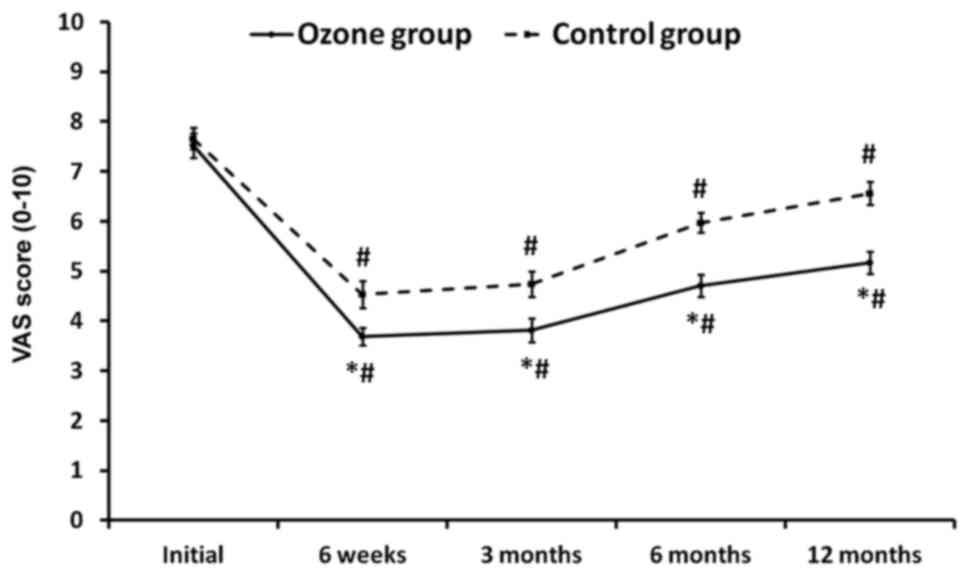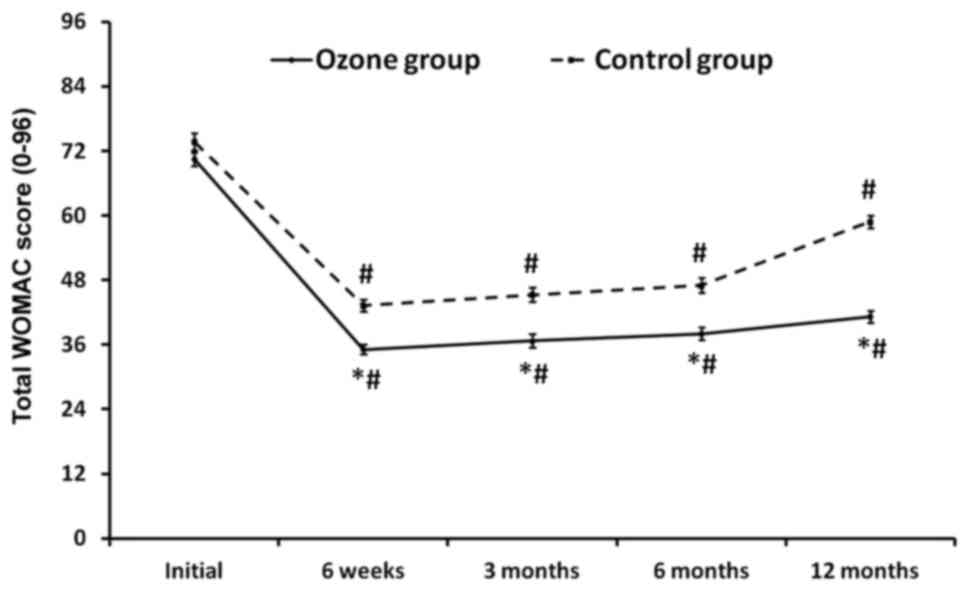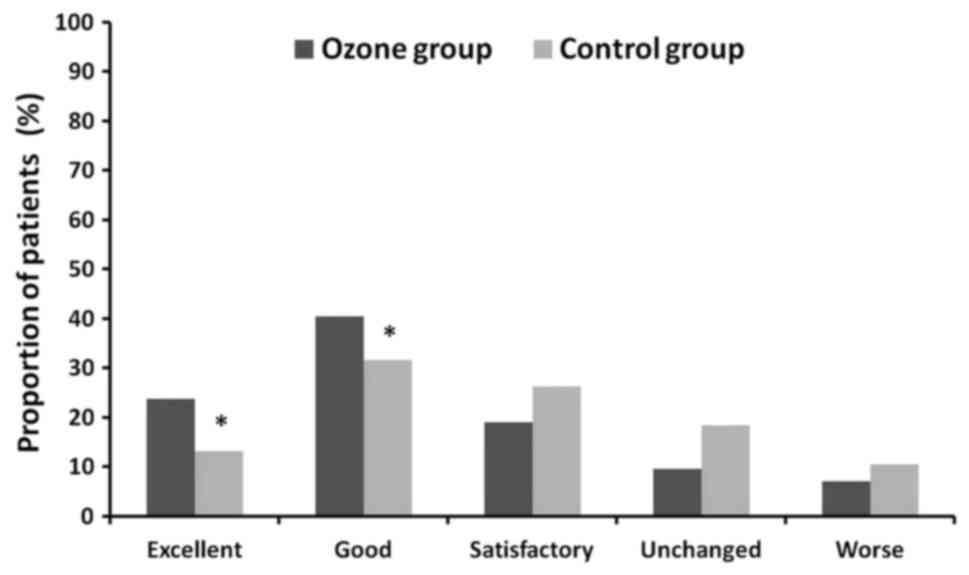|
1
|
Hawamdeh M Z and Al-Ajlouni JM: The
clinical pattern of knee osteoarthritis in jordan: A hospital based
study. Int J Med Sci. 10:790–795. 2013. View Article : Google Scholar : PubMed/NCBI
|
|
2
|
Pearse EO and Craig DM: Partial
meniscectomy in the presence of severe osteoarthritis does not
hasten the symptomatic progression of osteoarthritis. Arthroscopy.
19:963–968. 2003. View Article : Google Scholar : PubMed/NCBI
|
|
3
|
Hunt SA, Jazrawi LM and Sherman OH:
Arthroscopic management of osteoarthritis of the knee. J Am Acad
Orthop Surg. 10:356–363. 2002. View Article : Google Scholar : PubMed/NCBI
|
|
4
|
Jackson RW and Dieterichs C: The results
of arthroscopic lavage and debridement of osteoarthritic knees
based on the severity of degeneration: A 4- to 6-year symptomatic
follow-up. Arthroscopy. 19:13–20. 2003. View Article : Google Scholar : PubMed/NCBI
|
|
5
|
Figueroa D, Calvo R, Villalón IE, Meleán
P, Novoa F and Vaisman A: Clinical outcomes after arthroscopic
treatment of knee osteoarthritis. Knee. 20:591–594. 2013.
View Article : Google Scholar : PubMed/NCBI
|
|
6
|
Forster MC and Straw R: A prospective
randomized trial comparing intra-articular hyalgan injection and
arthroscopic washout for knee osteoarthritis. Knee. 10:291–293.
2003. View Article : Google Scholar : PubMed/NCBI
|
|
7
|
Mathies B: Effects of viscoseal, a
synovial fluid substitute, on recovery after arthroscopic partial
meniscectomy and joint lavage. Knee Surg Sports Traumatol Arthrosc.
14:32–39. 2006. View Article : Google Scholar : PubMed/NCBI
|
|
8
|
Hempfling H: Intra-articular hyaluronic
acid after knee arthroscopy: A two-year study. Knee Surg Sports
Traumatol Arthrosc. 15:537–546. 2007. View Article : Google Scholar : PubMed/NCBI
|
|
9
|
Ulucay C, Altintas F, Ugutmen E and Beksaç
B: The use of arthroscopic debridement and viscosupplementation in
knee osteoarthritis. Acta Orthop Traumatol Turc. 41:337–342.
2007.(In Turkish). PubMed/NCBI
|
|
10
|
Zietz PM and Selesnick H: The use of hylan
G-F 20 after knee arthroscopy in an active patient population with
knee osteoarthritis. Arthroscopy. 24:416–422. 2008. View Article : Google Scholar : PubMed/NCBI
|
|
11
|
Bocci V: Ozone as Janus: This
controversial gas can be either toxic or medically useful.
Mediators Inflamm. 13:3–11. 2004. View Article : Google Scholar : PubMed/NCBI
|
|
12
|
Fernandez-Cuadros ME, Perez-Moro OS and
Mirón-Canelo JA: Could ozone be used as a feasible future treatment
in osteoarthritis of the knee? Diversity Equal Health Care.
13:232–239. 2016.
|
|
13
|
Swapan ΚΜ, Rajesh P, Pallab D, Partha PD,
Asim KP, Jayanta R, Halder N and Rathindra NH: Role of
intra-articular ozone in osteo-arthritis of knee for functional and
symptomatic improvement. Ind J Phys Med Rehabil. 22:65–69.
2011.
|
|
14
|
Borrelli E, Alexandre A, Iliakis E,
Alexandre A and Bocci V: Disk herniation and knee arthritis as
chronic oxidative stress disieases: The therapeutic role of oxygen
ozone therapy. J Arthritis. 4:1612015.
|
|
15
|
Zhang JF, Zhan XQ, Hu HW, Yang Q and Wang
XH: Clinical results of medical ozone combined with sodium
hyaluronate for knee osteoarthritis. Orthop J China. 5:362–365.
2010.(In Chinese).
|
|
16
|
Kellgren JH and Lawrence JS: Radiological
assessment of osteo arthrosis. Ann Rheum Dis. 16:494–502. 1957.
View Article : Google Scholar : PubMed/NCBI
|
|
17
|
Price DD, McGrath PA, Rafii A and
Buckingham B: The validation of visual analogue scales as ratio
scale measures for chronic and experimental pain. Pain. 17:45–56.
1983. View Article : Google Scholar : PubMed/NCBI
|
|
18
|
Hashemi M, Jalili P, Mennati S, Koosha A,
Rohanifar R, Madadi F, Razavi SS and Taheri F: The effects of
prolotherapy with hypertonic dextrose versus prolozone
(intraarticular ozone) in patients with knee osteoarthritis. Anesth
Pain Med. 5:e275852015. View Article : Google Scholar : PubMed/NCBI
|
|
19
|
Lequesne MG: The algofunctional indices
for hip and knee osteoarthritis. J Rheumatol. 24:779–781.
1997.PubMed/NCBI
|
|
20
|
Bellamy N, Buchanan WW, Goldsmith CH,
Campbell J and Stitt LW: Validation study of WOMAC: a health status
instrument for measuring clinically important patient relevant
outcomes to antirheumatic drug therapy in patients with
osteoarthritis of the hip or knee. J Rheumatol. 15:1833–1840.
1988.PubMed/NCBI
|
|
21
|
Aaron RK, Skolnick AH, Reinert SE and
Ciombor DM: Arthroscopic debridement for osteoarthritis of the
knee. J Bone Joint Surg Am. 88:936–943. 2006. View Article : Google Scholar : PubMed/NCBI
|
|
22
|
Shin CS and Lee JH: Arthroscopic treatment
for osteoarthritic knee. Knee Surg Relat Res. 24:187–192. 2012.
View Article : Google Scholar : PubMed/NCBI
|
|
23
|
Huskin JP, Vandekerckhove B, Delincé P,
Verdonk R, Dubuc JE, Willems S, Hardy P, Blanco FJ, Charrois O and
Handelberg F: Multicentre, prospective, open study to evaluate the
safety and efficacy of hylan G-F 20 in knee osteoarthritis subjects
presenting with pain following arthroscopic meniscectomy. Knee Surg
Sports Traumatol Arthrosc. 16:747–752. 2008. View Article : Google Scholar : PubMed/NCBI
|
|
24
|
Calunga J L, Menéndez S, León R, Chang S,
Guanche D, Balbín A, Zayas J and García P: Application of ozone
therapy in patients withknee osteoarthritis. Ozone: Science &
Engineering. 34:469–475. 2012. View Article : Google Scholar
|
|
25
|
Bocci VA: Scientific and medical aspects
of ozone therapy. State of the art. Arch Med Res. 37:425–435. 2006.
View Article : Google Scholar : PubMed/NCBI
|
|
26
|
Duymus TM, Mutlu S, Dernek B, Komur B,
Aydogmus S and Kesiktas FN: Choice of intra-articular injection in
treatment of knee osteoarthritis: Platelet-rich plasma, hyaluronic
acid or ozone options. Knee Surg Sports Traumatol Arthrosc.
25:485–492. 2017. View Article : Google Scholar : PubMed/NCBI
|
|
27
|
Chansoria M, Upadhyay S, Panwar S,
Shivhare P and Vyas N: Comparative efficacy of intraarticular
injection of combination of ozone and steroid and ozone alone in
patients with primary knee osteoarthritis: A prospective,
randomized clinical analysis. J Recent Adv Pain. 2:11–14. 2016.
View Article : Google Scholar
|
|
28
|
Invernizzi M, Stagno D, Carda S, Grana E,
Picelli A, Smania N, Cisari C and Baricich A: Safety of
intra-articular oxygen-ozone therapy compared to intra-articular
sodium hyaluronate in knee osteoarthritis: A randomized single
blind pilot study. Int J Phys Med Rehabil. 5:3852017.
|
|
29
|
de Jesus Lopes CC, Dos Santos FC, de Jesus
LMOB, Monteiro I, Sant'Ana MSSC and Trevisani VFM: Comparison
between intra-articular ozone and placebo in the treatment of knee
osteoarthritis: A randomized, double-blinded, placebo-controlled
study. PLoS One. 12:e01791852017. View Article : Google Scholar : PubMed/NCBI
|
|
30
|
Fernández-Cuadros ME, Pérez-Moro OS,
Albaladejo-Florin MJ, et al: Ozone improves pain, function and
quality of life in patients with knee osteoarthritis: A prospective
quasi-experimental before-after study. Middle East J Rehabil
Health. 4:e418212017.
|















